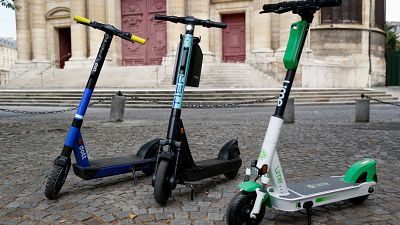E-scooter company Dott is using AI-powered cameras to study people’s use of their scooters.
While electric scooters are reserved for the road in most European countries, some people still use them on the pavement which can be disruptive and dangerous for pedestrians.
Franco-Dutch company Dott equipped their e-scooters with AI cameras, to gather data from over 3,000 trips and more than 6,000 km in two European cities - Brussels, Belgium and Grenoble, France - and in Tel Aviv, Israel.
They found that 93 per cent of the time e-scooters were used on roads and bike lanes.
When e-scooter users did ride on the pavement, three-quarters of the time it was due to road and infrastructure conditions, Dott said.
"The majority of people want to use public space in a respectful and safe way,” a Dott spokesperson said.
"It's therefore unsurprising that [pavement] riding occurs in only a small proportion of e-scooter use."
Dott found that 33 per cent of those riding on the pavement were accessing scooter parking while 23 per cent were on the pavement after using zebra crossings.
“Scooter users can feel vulnerable on our roads compared to cars, buses and trucks, and so if the infrastructure leads them to feel unprotected, it's to be expected that they move to an area they feel safer," the company said.
"Irresponsible rider behaviour" caused around a quarter of instances where an e-scooter was used on the pavement.
The company said it was working on solutions such as courses, targeted messages and ultimately restricting access to the service for frequent offenders.
E-scooter operators criticised
While Dott says a majority of e-scooter riders stick to the roads, there have been several high-profile accidents involving these scooters.
After fatal crashes in France, Sweden, and Spain over the past few years, authorities decided to crack down on e-scooters with regulations that range from preventing scooter use on the pavement, requiring helmets, or limiting their maximum speed.
Paris even went so far as to start banning rental e-scooters in September, a first in Europe. The decision occurred after a public vote.
Operators are now trying to do more to ensure the safer use of their scooters.
“Our service can be tailored and adapted to suit different city environments,” said Dott adding that it was sharing data and collaborating with cities on the challenges they face.
Laura Mollard-Dumont, the city of Grenoble’s mobility project manager, said in a statement that the AI-powered cameras on e-scooters could help city authorities and residents.
“It improves compliance [with] rules, preventing conflicts between pedestrians and riders. And it also provides us with new data, highlighting infrastructure which is not working as planned or misunderstood by users,” she said.
“These features demonstrate a further advantage of shared scooters over private vehicles, helping city authorities to better understand the different ways to move around the city.”
Studies will take place in Madrid, Lyon and London this fall to further understand how people use e-scooters across Europe, the company said.



